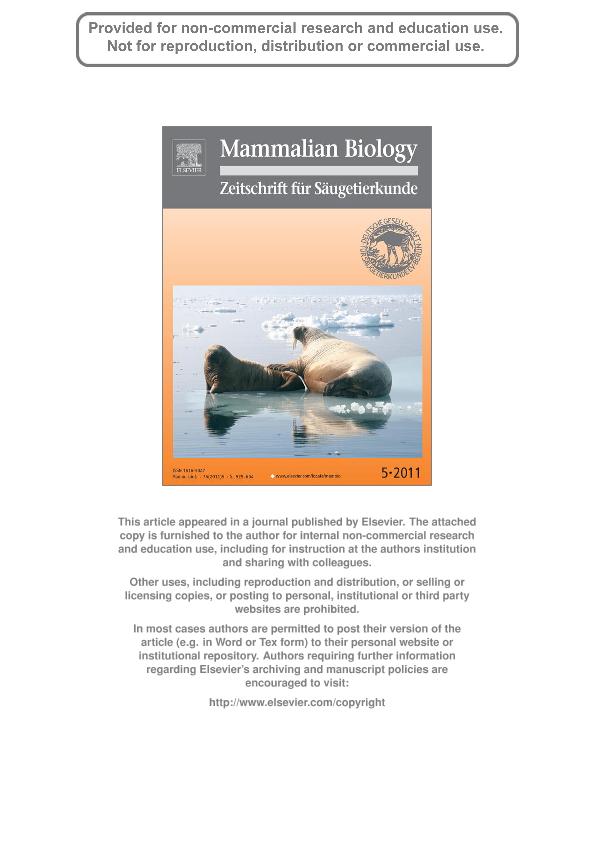Artículo
Integrated analyses of chromosome, molecular and morphological variability in the Andean mice Eligmodontia puerulus and E. moreni (Rodentia, Cricetidae, Sigmodontinae)
Lanzone, Cecilia ; Ojeda, Agustina Alejandra
; Ojeda, Agustina Alejandra ; Ojeda, Ricardo Alberto
; Ojeda, Ricardo Alberto ; Albanese, María Soledad
; Albanese, María Soledad ; Rodriguez, Maria Daniela
; Rodriguez, Maria Daniela ; Dacar, María Ana
; Dacar, María Ana
 ; Ojeda, Agustina Alejandra
; Ojeda, Agustina Alejandra ; Ojeda, Ricardo Alberto
; Ojeda, Ricardo Alberto ; Albanese, María Soledad
; Albanese, María Soledad ; Rodriguez, Maria Daniela
; Rodriguez, Maria Daniela ; Dacar, María Ana
; Dacar, María Ana
Fecha de publicación:
09/2011
Editorial:
Elsevier Gmbh
Revista:
Mammalian Biology
ISSN:
1616-5047
Idioma:
Inglés
Tipo de recurso:
Artículo publicado
Clasificación temática:
Resumen
Patterns of evolution and systematics of sigmodontine rodents are matters of continuous revision and debate. The silky mouse, Eligmodontia, is a phyllotine rodent adapted to arid environments. Chromosomal and molecular data have identified six species in this genus. Among these E. puerulus and E. moreni are sister taxa from the high Andean and lowland deserts, respectively, with large chromosomal differences and intermediate levels of molecular divergence. The purpose of our study was to quantify the degree of variability (morphological, cytogenetic, and molecular) and to analyze its evolutionary implications within, and between, these sister species in the Monte and Puna biomes of Argentina. Our results show a high variability at the chromosomal and molecular level, but low morphological differentiation among populations of E. puerulus. Diploid numbers vary from 31 to 37 due to a complex Robertsonian system, whereas cytochrome-b distances range from 0.15% to 5.75%. On the other hand, E. moreni shows high morphological differentiation between populations, but low intraspecific differentiation at the molecular (from 0.73% to 1.4%) and chromosomal level (2n = 52). Comparison of E. puerulus with E. moreni reveals high morphological and chromosomal distinction between them, but absence of molecular differentiation. Our results suggest that: (1) the high genetic variability of E. puerulus could be associated to its geographic distribution in the complex topography of the high Andean Puna; (2) the high morphological differentiation between E. moreni and E. puerulus could be the result of natural selection; and (3) molecular polyphyly between E. puerulus and E. moreni could be due to introgression or a recent split of these taxa. Finally, our results emphasize the need to integrate different datasets in the analysis of species variability and diversification, as tools for understanding their evolutionary histories.
Palabras clave:
Eligmodontia
,
Variability
,
Morphology
,
Cytogenetics
,
Cytocrome B
Archivos asociados
Licencia
Identificadores
Colecciones
Articulos(CCT - NORDESTE)
Articulos de CTRO.CIENTIFICO TECNOL.CONICET - NORDESTE
Articulos de CTRO.CIENTIFICO TECNOL.CONICET - NORDESTE
Articulos(IADIZA)
Articulos de INST. ARG DE INVEST. DE LAS ZONAS ARIDAS
Articulos de INST. ARG DE INVEST. DE LAS ZONAS ARIDAS
Citación
Lanzone, Cecilia; Ojeda, Agustina Alejandra; Ojeda, Ricardo Alberto; Albanese, María Soledad; Rodriguez, Maria Daniela; et al.; Integrated analyses of chromosome, molecular and morphological variability in the Andean mice Eligmodontia puerulus and E. moreni (Rodentia, Cricetidae, Sigmodontinae); Elsevier Gmbh; Mammalian Biology; 76; 5; 9-2011; 555-562
Compartir
Altmétricas



